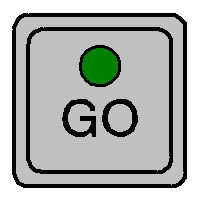|
Effects
| |
A cue or submaster which causes a group of channels to cycle through a sequence of
pre-established levels is called an "effect". There are several types of
effects and each console handles them differently. The most often used type
is the "step" effect. It is common to all modern consoles (although style
and terminology may differ from console to console) and is what we discuss
in this chapter.
A step effect operates by transferring control sequentially from one collection
of settings to the next. Each collection of settings is a "step" and in this
discussion, we refer to whichever step currently has control as the
"active" step.
Each step has several elements:
- Positive/Negative/Alternate: In a positive effect, the channels in the
active step are at their "high" levels and the channels in the inactive steps
are at their "low" levels.
Hover your mouse over the "GO" button for an
example of a positive effect. Imagine that the yellow
circles are lamps with their intensities set at 100% (the "high"
level for this effect) and that the gray circles are lamps that
are at 0% (the "low" level):

 In a negative effect, the active channels are at their low
levels and the inactive channels are at their high levels.
Hover your mouse over the "GO" button for an
example of a negative effect:
In a negative effect, the active channels are at their low
levels and the inactive channels are at their high levels.
Hover your mouse over the "GO" button for an
example of a negative effect:

 In an alternate effect,
the cycles switch from positive and negative and then back again.
In an alternate effect,
the cycles switch from positive and negative and then back again.
- Step Number: Each step has a unique number, and is edited individually.
- Channel: The channel (or channels) which will be controlled by this step,
when the step is active. Depending upon the individual console, for the effect
to work properly, it may be necessary to take these channels out
before running the effect.
- Step Time: The amount of time between the point at which one step is triggered and the
point at which the next step is triggered.
- "In" Time: The amount of time, starting with the step's being triggered, that it
takes for the active channels to fade up to their "high" level.
- "Dwell" Time: The amount of time, starting with the completion of the fade-up
specified in the "in" time, that the active channels remain at their "high" level.
- "Down" Time: The amount of time, starting with the end of the "dwell" time, that it
takes for the active channels to fade down to their "low" level.
- "High" Level: The level to which the step's channels fade when the step is active.
- "Low" Level: The level to which the step's channels fade when another step is inactive.
- Direction: Possible directions include:
- Forward: The steps are triggered in numerical order, repeating until the effect ends.
- Reverse: The steps are triggered in reverse numerical order – from the highest-numbered
step to step #1, repeating until the effect ends.
- Bounce: The steps are triggered in numerical order and then in reverse numerical
order, repeating until the effect ends.
- Build:
- In a positive effect, all channels begin at their low levels. As each step
is triggered, its channels come to their high levels, but the channels in
the previous step do not revert to their low levels, remaining at the higher setting.
At the completion of each iteration of the effect, all channels are at their
high levels and are then reset to their low levels as the effect starts its
next cycle.
- In a negative effect, all channels begin at their high levels and as each step
is triggered, its channels come to their low levels. At the completion of each
iteration of the effect, all channels are at their
low levels and are then reset to their high levels as the effect starts its
next cycle.
- Random: The steps are triggered in a random order. This is useful when making lights
appear to twinkle or when creating a fire effect. With most consoles, the speed of a random
effect can also be randomized.
This is the effects editing screen from Electronic Theatre Controls' Express
line of consoles:

| |
| |